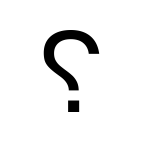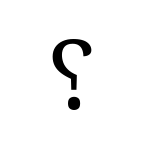Reversed Question Mark ⸮
Symbol Meaning
Although in the written English language there is no standard way to denote irony or sarcasm, several forms of punctuation have been proposed. Among the oldest and frequently attested are the percontation point invented by English printer Henry Denham in the 1580s, and the irony mark, furthered by French poet Alcanter de Brahm in the 19th century. Both of these marks were represented visually by a backwards question mark.
These punctuation marks are primarily used to indicate that a sentence should be understood at a second level. A bracketed exclamation point and/or question mark as well as scare quotes are also sometimes used to express irony or sarcasm.
The symbol “Reversed Question Mark” is included in the “Historic punctuation” subblock of the “Supplemental Punctuation” block and was approved as part of Unicode version 5.1 in 2008.
Synonyms
punctus percontativus, irony, sarcasm.
| Unicode Name | Reversed Question Mark |
| Unicode Number | |
| Plane | 0: Basic Multilingual Plane |
| Unicode Block | Supplemental Punctuation |
| Unicode Subblock | Historic punctuation |
| Unicode Version | 5.1 (2008) |
| Type of paired mirror bracket (bidi) | None |
| Composition Exclusion | No |
| Case change | 2E2E |
| Simple case change | 2E2E |
| Grapheme_Base | + |
| scripts | Common |
| Terminal_Punctuation | + |
| Sentence_Terminal | + |
| Pattern_Syntax | + |
| Encoding | hex | dec (bytes) | dec | binary |
|---|---|---|---|---|
| UTF-8 | E2 B8 AE | 226 184 174 | 14858414 | 11100010 10111000 10101110 |
| UTF-16BE | 2E 2E | 46 46 | 11822 | 00101110 00101110 |
| UTF-16LE | 2E 2E | 46 46 | 11822 | 00101110 00101110 |
| UTF-32BE | 00 00 2E 2E | 0 0 46 46 | 11822 | 00000000 00000000 00101110 00101110 |
| UTF-32LE | 2E 2E 00 00 | 46 46 0 0 | 774766592 | 00101110 00101110 00000000 00000000 |
Copy and paste these codes to use the Reversed Question Mark character in text for websites, social media, messengers, or blog posts.
| HTML | |
| CSS | |
| JavaScript, JSON | |
| Unix, C, PHP, JAVA | |
| Ruby, PHP | |
| Perl | |
| URL-encode |




